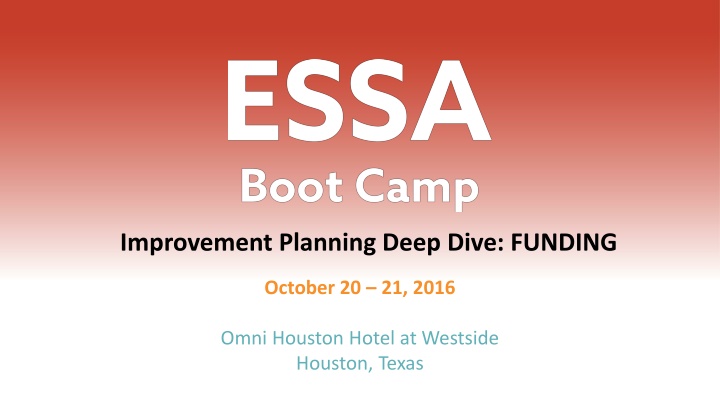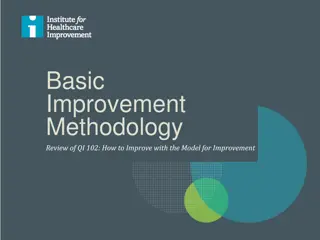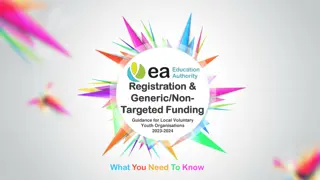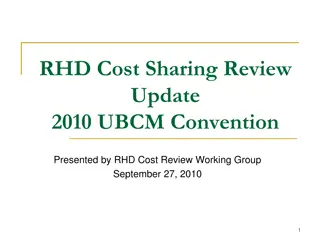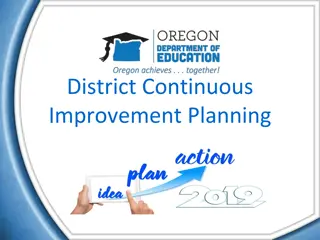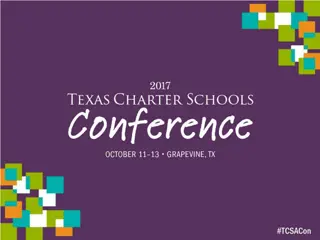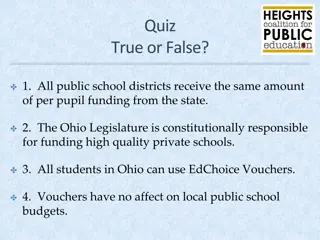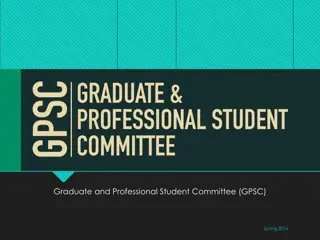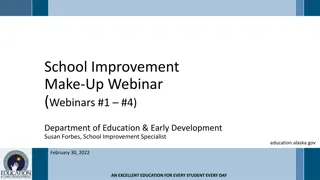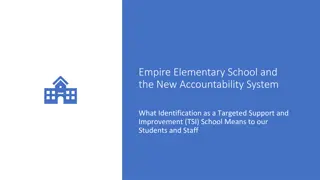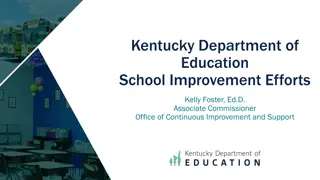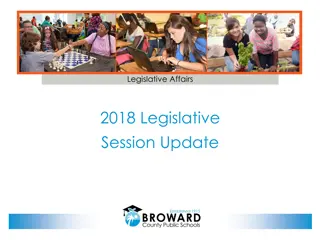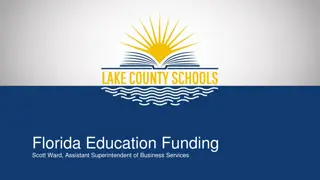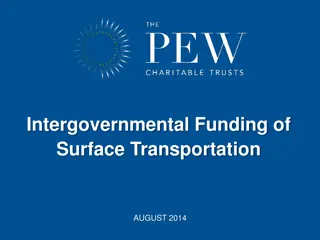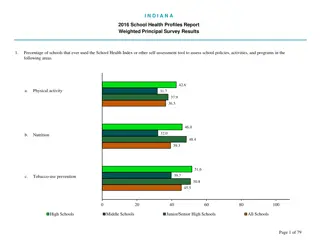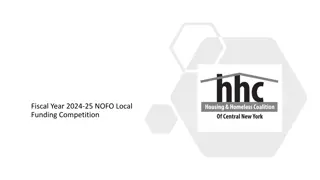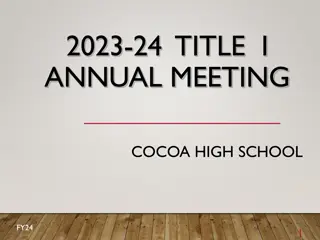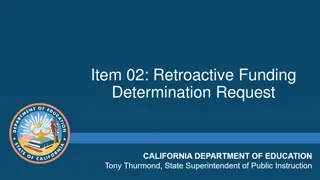Funding and Planning for School Improvement
ESSA provides about $1 billion per year for struggling schools' improvement plans. States must decide how to distribute funds wisely, considering existing resources and leveraging other funding sources. School improvement planning focuses on needs assessment and changing practices to enhance student outcomes. Explore an example of improvement planning at Chandler Elementary School in Worcester, Massachusetts.
Download Presentation

Please find below an Image/Link to download the presentation.
The content on the website is provided AS IS for your information and personal use only. It may not be sold, licensed, or shared on other websites without obtaining consent from the author.If you encounter any issues during the download, it is possible that the publisher has removed the file from their server.
You are allowed to download the files provided on this website for personal or commercial use, subject to the condition that they are used lawfully. All files are the property of their respective owners.
The content on the website is provided AS IS for your information and personal use only. It may not be sold, licensed, or shared on other websites without obtaining consent from the author.
E N D
Presentation Transcript
SUBTITLE Improvement Planning Deep Dive: FUNDING October 20 21, 2016 Omni Houston Hotel at Westside Houston, Texas ESSA Boot Camp | October 2016
ESSAs Big School Improvement Fund ESSA s Big School Improvement Fund ESSA will provide about $1 billion per year in funding to support improvement plans for struggling schools identified based on the indicators and ratings we have been talking about: Bottom 5% of Title I schools Schools with one or more underperforming groups of students States will need to make big decisions about how those funds get distributed and used to support improvement activities in those schools. However before we talk about those decisions, let s review some important context to keep in mind. ESSA Boot Camp | October 2016
Key Context Key Context for State Decisions about School for State Decisions about School Improvement Funds Improvement Funds 1. Many improvement activities will not require additional funding (especially if needs assessment is honest and probing). 2. Schools can often leverage existing resources more effectively for school improvement. 3. Other kinds of federal, state, and local dollars can be used to fund improvement activities. ESSA Boot Camp | October 2016
1. 1. Many improvement activities Many improvement activities will not require additional require additional funding funding will not School improvement planning requires a needs assessment to determine what the school must do differently to improve outcomes. Sometimes that can mean adding new programs or upgrades, but it can often mean changing adult practices in basic but powerful ways. ESSA Boot Camp | October 2016
1. 1. Many improvement activities Many improvement activities will not require additional require additional funding funding EXAMPLE from an improvement plan for Chandler Elementary School, Worcester, Massachusetts: will not The school leaders know that in order to rapidly accelerate the academic achievement of all Chandler Elementary students they must develop the competencies of the all adults in the school and continuously monitor instructional practice in tandem with close monitoring of student achievement. The principal and assistant principal have developed a schedule for daily classroom visits or mini-observations which include observations of student engagement with learning tasks, elements of the organization of the classroom, language-rich interactions, connection of the lesson to learning standards and objectives, evaluation of the rigor of learning tasks and other aspects of the Worcester Public Schools Framework for High Quality Teaching and Learning ESSA Boot Camp | October 2016
2 2. Schools can often leverage existing . Schools can often leverage existing resources more resources more effectively effectively The most common use of targeted school improvement funding is teacher professional development. In most schools, teachers already have various kinds of professional development opportunities. Research shows that how that time is spent matters hugely. ESSA Boot Camp | October 2016
2 2. Schools can often leverage existing . Schools can often leverage existing resources more resources more effectively effectively Example: Time set aside for teachers to collaborate with colleagues is the single biggest cost for professional development at the school level. One study followed a group of Title I schools using this strategy as a primary activity for school improvement. Student outcomes improved when teacher teams used an explicit process to 1) analyze data to identify student learning problems, 2) select and try new instructional strategies, 3) reconvene and analyze student work for evidence of impact, and 4) keep honing teaching strategies until students achieved the desired results. Student outcomes did not improve when teachers used the time in less focused and structured ways, e.g., when they used the time to share ideas. ESSA Boot Camp | October 2016
3. Other kinds of federal, state, and local dollars can be used to fund improvement activities Federal Title I, Part A Schoolwide Option Title I, Part A is the biggest source of federal K-12 funding: + $14 billion Qualifying Title I schools can opt to spend those funds to support a schoolwide improvement plan based on needs assessment. Requires 40% poverty threshold, but ESSA allows states to waive that requirement. 70 percent of Title I schools alreadyuse this schoolwide option. Schools have broad flexibility in selecting improvement activities, as long as they addresses a priority identified in the needs assessment. Schools can consolidate other federal funds with these funds. HOWEVER, many schools still do not understand/believe they have this much flexibility, and states have not been diligent in addressing misunderstandings. ESSA Boot Camp | October 2016
3. 3. Other kinds of federal, state, and local dollars can Other kinds of federal, state, and local dollars can be used to fund improvement activities be used to fund improvement activities In September, U.S. ED issued guidance with examples of how Title I Schoolwide funds can be used for a range of improvement activities, such as High-quality preschool or full-day kindergarten Recruitment and retention of effective teachers Instructional coaches to provide high-quality, school-based professional development Increased learning time Evidence-based strategies to accelerate the acquisition of content knowledge for English learners Activities to increase access to and prepare students for success in advanced coursework Counseling, mentoring, or other strategies to improve non-academic skills Interventions to improve school climate Equipment, materials, and training to analyze student achievement data to monitor progress, alert the school to struggling students, and drive decision making Response-to-intervention strategies for early identification of students with learning or behavioral needs and tiered interventions based on need Activities shown to be effective at increasing family and community engagement in the school ESSA Boot Camp | October 2016
3. 3. Other kinds of federal, state, and local dollars can Other kinds of federal, state, and local dollars can be used to fund improvement activities be used to fund improvement activities Federal Title II, Part A Funds activities to improve teaching and school leadership: + $2 billion Funds more often spent at district level, but districts could target them to address teacher- and leader-related needs in school improvement plans Example: Support and training for principals and other school leaders to lead school improvement efforts Example: Support and training for teachers in common areas of student need / instruction Example: Addressing inequities in access to qualified and effective teachers and leaders Title II funds often considered in isolation, not aligned with Title I spending or with school improvement plans and funding. ESSA Boot Camp | October 2016
3. 3. Other kinds of federal, state, and local dollars can Other kinds of federal, state, and local dollars can be used to fund improvement activities be used to fund improvement activities State and local funding But that depends on your state s context Before the recession, many states provided dedicated funds for school improvement, in some cases tens or hundreds of millions of dollars. However, state and local funding for education is still not back up to pre-recession levels in 31 states. We also know, from Ed Trust research, that low-income students and students of color receive fewer state and local dollars in many states. Important to know your state context as you think about policy and advocacy. ESSA Boot Camp | October 2016
From Two Federal Improvement From Two Federal Improvement F Funds to One unds to One NCLB 2015-16 ESSA 2017-18 $1,100,000,000 $1,000,000,000 $1,000,000,000 $800,000,000 $800,000,000 $596,000,000 $600,000,000 $600,000,000 $450,000,000 $400,000,000 $400,000,000 $200,000,000 $200,000,000 $0 1003(a) 4% Title I School Improvement Set-Aside 1003(g) SIG Program $0 1003(a) 7% Title I School Improvement Set-Aside ESSA Boot Camp | October 2016
Title I 7% Set Title I 7% Set- -Aside Aside Some Basics Some Basics Out of that set-aside, states may reserve up to 5% for state activities, with the rest going to LEAs for school improvement States must set aside 7% of total Title I, Part A allocation Title I, A State Allocation Set-Aside for Improvement Title I A Funds Improvement Set-Aside State Activities Subgrants to LEAs ESSA Boot Camp | October 2016
Title I 7% Set Title I 7% Set- -Aside Aside Some Basics, Some Basics, continued continued Unlike SIG, almost no federal restrictions on how funds may be spent Only restriction: Must support evidence-based strategies (i.e., activities, practices, interventions that have some formal research backing) States may award grants on a formula or competitive basis States must consider three priorities for awarding grants, but ESSA leaves the definitions mostly up to the states Number or proportion of schools identified for improvement Need for improvement funding Commitment to enabling the lowest-performing schools to improve student outcomes With approval of district, states may directly spend funds that normally would be subgranted to district to pay for school improvement activities (e.g., services or supports provided by state agency or other entities) ESSA Boot Camp | October 2016
Title I 7% Set Title I 7% Set- -Aside Aside Some Basics, Some Basics, continued continued Nothing in ESSA restricts states from allocating funds to consortia of districts or to education service agencies (if those entities legally qualify as local education agencies in a state) Local education agencies must submit an applications to the state to receive funds States must annually report which local education agencies and schools received funds, amount each school received, and strategies implemented in each school with support from these funds Big change from 2008, when four states could not tell the U.S. General Accounting Office which schools received funds from the set-aside! ESSA Boot Camp | October 2016
Some Major State Decision Points Some Major State Decision Points Should the state allocate these funds to LEAs based using formula grants, competitive grants, or both? To what extent should the state constrain how these funds can be used? In what ways, given the state s unique context? How long should the grants last? ESSA allows grants to be up to four years, and the first year can be a planning year. If longer than two years, should schools be expected to show progress on leading indicators for subsequent rounds of funding? How large should the grants be? Should the state set floors or ceilings for different types of schools? How should the state define need and commitment to lowest- performing schools ? Should the state allow or encourage consortia of districts or education services agencies to apply for funds? ESSA Boot Camp | October 2016
That Gives States That Gives States Lots Let s Consider Just the First Two Decision Points Let s Consider Just the First Two Decision Points Lots of Leeway of Leeway Less Constrained Use More Constrained Use Georgia: For FY 2014-2015, all Priority, Focus, Alert schools received a base of $33K. Non-SIG Priority and Focus Schools received additional funds based on each school s designation. Non-SIG Priority schools received a supplement based on the size of the school. Funds can be used for wide range of activities based the needs assessment. Indiana: For 2015-16, eligible Priority and Focus schools can apply for either $10K or $15K to support activities in any of four areas: teacher retention, family and community involvement, increased learning time, pre- kindergarten initiatives. Schools must choose from a defined menu of interventions within each type of activity. Formula Grants Incentivize Use of Diagnosis-Driven, Evidence Based Strategies: Award competitive points for deep/thorough diagnostic needs assessment; use of strategies tied to needs; selection of strategies based on higher levels of research evidence; theory of action for how will improve outcomes. Colorado: The state has used its 1003(a) set- aside to fund three separate competitive grant programs: 1) Diagnostic Review and Planning Grant Program 2) Reading Ignite Literacy Grant Program 3) Connect for Success Grant Program Competitive Grants ESSA Boot Camp | October 2016
Close Up on Close Up on Colorado s Competitive Grants Colorado s Competitive Grants Diagnostic Review and Planning Grant Program Eligible schools may apply for up to $50,000 to engage a state-approved provider to conduct an on-site diagnostic review (needs assessment) and an approved provider to help write improvement plan based on the findings of the diagnostic review. Reading Ignite Literacy Grant Program Eligible LEAs may apply for one of 1-20 grants, ranging in size from $75,000 to $125,000, to enable Priority or Turnaround schools to embed essential components of supplemental reading instruction. Connect for Success Grant Program Priority and Turnaround schools may apply for grants to implement structures and strategies found to be effective through the High Achieving Schools study and provide quality instruction to meet needs of minority students, students experiencing poverty, students with disabilities, and English Learners. Source, Colorado Department of Education, https://www.cde.state.co.us/fedprograms/ti/sitig#cfsg ESSA Boot Camp | October 2016
Reminder: Only Reminder: Only Federal Set Set- -Aside Funds Is Evidence Aside Funds Is Evidence- -Based Federal Constraint on Use of Constraint on Use of Based Therefore, these funds could be spent on non-academic student supports, strategies to improve school climate, family and community engagement, etc. as long as the strategy is backed by research Example: Massachusetts Wraparound Zones (WAZ) Grant Program Funds awarded to 32 turnaround schools in seven districts, 2011-14 Addressed the holistic needs of students by enhancing school climate; identifying students with nonacademic needs; integrating social service resources; engaging families. Many grantees created partnerships with local mental health clinics and other community providers. A quasi-experimental research study found that WAZ contributed to higher rates of student improvement on state math and language arts assessments. (AIR, 2015) ESSA Boot Camp | October 2016
State Design Decisions Can Have Huge State Design Decisions Can Have Huge Consequences Consequences Thought Exercise Thought Exercise ED s proposed ESSA regulations would require the 5% lowest- performing schools to be funded at $500K per year, while schools identified for consistent underperformance among one or more student groups would receive $50K per year. What would that look like given current Title I allocations? Turns out, the funds would run out pretty quickly ESSA Boot Camp | October 2016
State Design Decisions Can Have Huge State Design Decisions Can Have Huge Consequences Consequences Thought Exercise Thought Exercise Number of those schools that could be funded at $500K minimum per school Number of those schools that could NOT be funded with $500K floor How many "lowest- performing 5% of Title I schools"? Percent of schools that could not be funded 7% Improvement "Set-Aside" $15,520,210 Title I Schools (2014) Title I Funds (2015) 221,717,283 1,684,685,737 $117,928,002 150,077,888 44,353,281 499,202,660 47,116,137 663,983,900 258,377,005 211,845,665 State Alabama California Colorado Delaware Georgia Hawaii Illinois Indiana Kentucky 901 7092 657 182 1608 191 3240 1513 1079 45 355 33 31 236 21 14 119 12 31% 33% 36% 32% 13% 31% 43% 52% 45% $10,505,452 $3,104,730 $34,944,186 $3,298,130 $46,478,873 $18,086,390 $14,829,197 9 6 3 80 10 162 76 54 70 7 93 36 30 11 3 69 39 24 ESSA Boot Camp | October 2016
State Design Decisions Can Have Huge State Design Decisions Can Have Huge Consequences Consequences Thought Exercise Thought Exercise Number of those schools that could be funded at $500K minimum per school Number of those schools that could NOT be funded with $500K floor How many "lowest- performing 5% of Title I schools"? Percent of schools that could not be funded 7% Improvement "Set-Aside" $19,891,546 $13,712,492 $34,907,282 $10,403,061 $77,310,747 $29,196,204 $39,082,441 $19,859,683 $92,451,270 $16,117,357 Title I Schools (2014) Title I Funds (2015) $284,164,949 $195,892,739 $498,675,460 $148,615,160 $1,104,439,248 $417,088,622 $558,320,583 $283,709,751 $1,320,732,434 $230,247,957 State Louisiana Maryland Michigan Minnesota New York North Carolina Ohio Tennessee Texas Washington 1123 795 2337 884 4651 2155 2899 1511 7066 1572 56 40 117 44 233 108 145 76 353 79 40 27 70 21 155 58 78 40 185 32 16 12 47 23 78 49 67 36 168 46 29% 31% 40% 53% 34% 46% 46% 47% 48% 59% ESSA Boot Camp | October 2016
Bottom Line Bottom Line This is not just about how states will distribute a big pot of school improvement funding. This is about whether states will leverage the money and the process to encourage schools and districts to think deeply and strategically about improvement, taking into account all available resources. ESSA Boot Camp | October 2016
Discussion Discussion Big State Decisions for Set-Aside Should the state allocate funds to LEAs based using formula grants, competitive grants, or both? To what extent should the state constrain how funds can be used? In what ways, given the state s unique context? How long should the grants last? ESSA allows grants to be up to four years, and the first year can be a planning year. If longer than two years, should schools be expected to show progress on leading indicators for subsequent rounds of funding? How large should the grants be? Should the state set floors or ceilings for different types of schools? How should the state define need and commitment to lowest-performing schools ? Should the state allow or encourage consortia of districts or education services agencies to apply for funds? Key Context to Keep in Mind Many improvement activities will not require additional funding (especially if needs assessment is honest and probing). Schools can often leverage existing resources more effectively for school improvement. Other kinds of federal, state, and local dollars can be used to fund improvement activities. ESSA Boot Camp | October 2016
Additional Information for Context Additional Information for Context ESSA Boot Camp | October 2016
Inflation Inflation- -Adjusted Change in K12 Spending Per Student, 2008 Adjusted Change in K12 Spending Per Student, 2008- -2014 2014 15% 10% 5% 0% -5% -10% -15% -20% -25% Percent change in STATE funding Percent change in STATE + LOCAL funding Source: Center on Budget & Policy Priorities, January 2016. ESSA Boot Camp | October 2016
State and Local Funding Equity ESSA Boot Camp | October 2016
